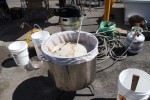 After a particularly traumatizing filtration with a highly non-flocculent yeast (WLP570 for all you curious folks out there), I decided that this week may be a good time to talk a little about this often ignored but extremely important facet of yeast activity. I promise not to get too overly scientific (for a more scientific look, I recommend Fix’s Principles of Brewing Science). Come along with me on this journey, won’t you?
After a particularly traumatizing filtration with a highly non-flocculent yeast (WLP570 for all you curious folks out there), I decided that this week may be a good time to talk a little about this often ignored but extremely important facet of yeast activity. I promise not to get too overly scientific (for a more scientific look, I recommend Fix’s Principles of Brewing Science). Come along with me on this journey, won’t you?
First, let’s start with a definition. Mirriam-Webster’s online dictionary defines “flocculate” as “to cause to aggregate into a flocculent mass”. Not terribly useful to us, but it’s a start. In short, flocculation in the context of brewing is when yeast cells feel that they’ve finished their job of fermentation and decide to grab on to other yeast cells to form clumps in the fermenting wort. Without flocculation, all non-filtered beers would taste quite yeasty and visually resemble murky pond water. Filtration would also be extremely difficult, as I mentioned above. Imagine stirring a whole gluestick into your pint and then trying to scrape it out with a series of mesh screens. You can even take it beyond imagining and actually give it a try if you are feeling particularly masochistic today, but I don’t recommend it.
Now that we know what flocculation is, let’s talk about how it happens and why we care. The ability to flocculate is a genetically inherited trait that can manifest differently in different strains of yeast. Many strains of ale yeast have a tendency to flocculate upward forming the foamy crust at the top of a fermenting ale, many lager strains tend to flocculate down, forming a thicker bottom bed, and many yeast strains have a strong tendency to remain in suspension. Slight variations to each strain may even perform quite differently than the core strain, which is part of why nearly all ales still flocculate to the bottom of the fermenter as well. To add another layer of complexity, more highly flocculent strains can attach to less flocculent strains and pull them out of suspension. This is the reason that a pitch taken from the bottom of a fermenter is not exclusively populated by the most flocculent strains, although a bottom-pitch method does encourage higher flocculation in subsequent fermentations.
Once the genetic tendency to flocculate is present, there are a number of environmental factors that influence flocculation. These include agitation, sugar and ethanol levels, temperature, and the presence of free calcium ions. Agitation of the wort can negatively influence flocculation by making it more difficult for yeast cells to attach to one another. Sugar levels and ethanol levels have inverse impacts on flocculation. Because sugar is the food of fermentation and ethanol is a waste product, lower levels of fermentable sugars cause flocculation as a survival response to a lack of food. Similarly, high ethanol levels signal an excess of waste product, which encourage flocculation as a survival response. Temperature also encourages flocculation as it drops out of the preferred fermentation zone for a given yeast strain. In the brewing industry we call this “crashing” a beer. When we reach the desired level of fermentation, we cool the beer to stop fermentation and encourage flocculation. Lastly, free calcium ions encourage healthy flocculation because the yeast cells use them to form the bridges or, as I like to call them, “grabbers” that attach cells to each other.
If flocculation is so good, Dr. Beerwizard, why don’t all brewers just use the most flocculent strains they can find? I’m glad you asked. The reason is that flocculation is a post-fermentation response, which means that no further alcohol or other fermentation byproducts (such as esters and phenols) are made by flocculated yeast until they are introduced into a less flocculation-encouraging environment (see factors above). We do want very good flocculation but not until after the job of fermentation has been done. Extremely good flocculators tend to be lower attenuating. By the same token, extreme attenuators, such as brettanomyces, tend to be very poor flocculators. Attenuation, however, is a discussion best left for another day. Until then, faithful readers, thanks for reading, and happy drinks.
P.S. Remember to let me know if you have some specific topic you would like me to babble about next time. You can tell me in person, by e-mail, or in the comments right down below.





